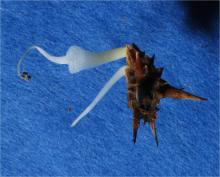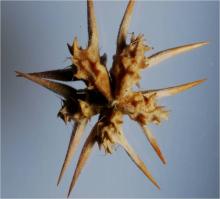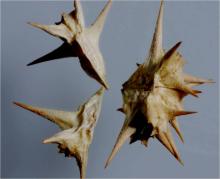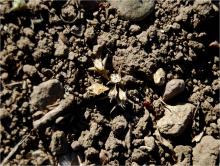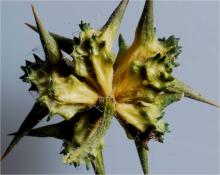2,4-D amine or 2,4-D LV ester
Rate 1 to 2 lb ae in 10 to 20 gal water for spot treatments.
Time Apply every 3 weeks during growing season or when new seedlings appear.
Remarks Seed will germinate throughout the summer when moisture is available.
Caution Avoid drift to sensitive crops.
Site of action Group 4: synthetic auxin
Chemical family Phenoxy acetic acid
aminocyclopyrachlor + chlorsulfuron (Perspective)
Rate 1.8 to 3.2 oz/A aminocyclopyrachlor + 0.7 to 1.3 oz/A chlorsulfuron (4.5 to 8 oz/A of product)
Time Apply to actively growing plants in spring.
Remarks Adjuvants can be used; these include methylated seed oils 0.5 to 1% v/v, nonionic surfactants at 0.25 to 1% v/v, and crop oil concentrates at 1% v/v. Can be applied using an invert emulsion rather than water.
Caution Even low rates can kill nontarget tree and shrub species, so avoid application within a distance equal to the tree height of the sensitive species. Do not allow spray to drift off target. Can injure several grass species including bromes, as well as basin wildrye.
Site of action (aminocyclopyrachlor) Group 4: Synthetic auxin; (chlorsulfuron) Group 2: ALS inhibitor
Chemical family (aminocyclopyrachlor) Pyrimidine carboxylic acid; (chlorsulfuron) Sulfonylurea
bentazon (Basagran) + imazamox (Raptor)
Rate 0.75 to 1 lb ai/A bentazon + 0.031 lb ai/A imazamox (4 oz/A Raptor)
Time Apply to small, actively growing puncturevine.
Remarks Controls puncturevine in snap beans where few other products are registered for use and puncturevine control is critical. Does not provide residual control of puncturevine. Tank-mixing Basagran with Raptor improves crop safety and puncturevine control. Add a nonionic surfactant or crop oil and nitrogen-based fertilizer to improve weed control.
Caution Do not apply to drought-stressed bean plants or plants with poor root development.
Site of action (bentazon) Group 6: photosystem II inhibitor; (imazamox) Group 2: acetolactate synthase (ALS) inhibitor
Chemical family (bentazon) Benzothiadiazole; (imazamox) Imidazolinone
bromacil + diuron (Krovar I DF)
Rate 8 lb ai/A (10 lb/A)
Time Apply before weeds emerge.
Remarks Rain is needed to activate this herbicide.
Caution Nonselective weed control. Do not apply where desirable plant roots extend.
Site of action Group 5: photosystem II inhibitor
Chemical family (bromacil) Uracil; (diuron) Urea
chlorsulfuron (Telar)
Rate 1 oz ai/A (1.5 oz/A)
Time Apply late fall or late winter preemergence to growth. Needs moisture to activate.
Remarks May be used selectively or tank-mixed with other selective or bareground herbicides. Use only on pasture, range, Conservation Reserve Program (CRP), and non-cropland.
Caution Do not let spray drift onto sensitive crops.
Site of action Group 2: acetolactate synthase (ALS) inhibitor
Chemical family Sulfonylurea
fomesafen (Reflex)
Rate 1 to 2 pints/A (0.25 to 0.5 lb ai/A)
Time Pre- and postemergence, depending on crop.
Remarks Because moisture is necessary to activate Reflex in soil for residual weed control, the herbicide may be more effective if rainfall or irrigation occurs shortly after application. If adequate rainfall is not received after a Reflex application, at least 0.25 inch overhead sprinkler irrigation before weeds emerge may improve weed control. Mechanically incorporating into soil, or cultivating after applying, reduces residual weed control and is not recommended. Reflex effectiveness will be reduced if later cultural practices expose nontreated soil.
Caution Only labeled in potatoes, cucurbits, snap beans, and edamame. Potato varieties may vary in their response to Reflex.
Site of action Group 14: protoporphyrinogen oxidase (Protox) inhibitor
Chemical family Nitrophenylether
imazapic (Plateau)
Rate 0.125 to 0.188 lb ai/A
Time Apply early postemergence when plants are cracking.
Remarks Add 1 quart/A methylated seed oil; do not exceed 25 gal/A spray volume.
Caution Before using, note crop rotation restrictions.
Site of action Group 2: acetolactate synthase (ALS) inhibitor
Chemical family Imidazolinone
indaziflam (Rejuvra)
For non-crop or restoration areas
Rate Grazed areas 0.046 to 0.065 lb ai/A (3.5 to 5 oz/A Rejuvra); areas not grazed or cut for hay 0.046 to 0.09 lb ai/A (3.5 to 7 oz/A Rejuvra). Use lower rates only where weed pressure is light and shorter period of residual activity is desired.
Time Apply at least several weeks prior to expected germination of puncturevine Apply to dry soils when rain is not expected for at least 48 hr. Can be successfully applied several months in advance of weed germination.
Remarks Pre-emergent activity only. Short term control with long-term suppression that may last a year or more. Indaziflam is safe over the top of most well-established species. Do not expect to conduct successful seedings of desirable plants for several years after application.
Caution Adequate binding time on dry soil reduces risk of indaziflam moving into the root zone of desirable plants. Do not exceed a maximum rate of 0.065 lb ai/A (5 oz/A Rejuvra) in a single application. Do not make more than 2 applications in a 12-month period. Allow at least 60 days between applications.
Site of action Group 29, inhibition of cellulose biosynthesis
Chemical family Alkylazine
MSMA (Bueno or Trans-Vert)
Rate 2 to 4 lb ai/A
Time Apply after puncturevine emerges. Best results in seedling stage of growth.
Remarks MSMA is more active above 70°F. Regrowth after rain or overhead irrigation may need respraying.
Caution Keep liquid or dust away from eyes. Wash eyes immediately with water if exposed.
Site of action Group 17: not well understood
Chemical family Organoarsenical
norflurazon (Solicam)
Rate Refer to label. Adjust rates depending on soil texture and organic matter.
Time Apply in fall to spring, before puncturevine emerges.
Remarks Remove existing weeds mechanically or by a suitable postemergent herbicide.
Site of action Group 12: bleaching; inhibits carotenoid biosynthesis
Chemical family Pyridazinone
paraquat (Gramoxone Max)
Rate 0.38 to 0.49 lb ai/A
Time Apply as a postemergence spray to puncturevine foliage.
Remarks Results are best when puncturevine is in the seedling stage. Add 8 to 16 fl oz/100 gal nonionic surfactant to spray mix. Paraquat is a contact herbicide requiring thorough spray coverage. Puncturevine emerging after application will not be controlled.
Caution A restricted-use herbicide. Do not use around homes or other areas contacted by children or pets. Do not breathe spray mist.
Site of action Group 22: photosystem I electron diversion
Chemical family Bipyridilium
topramezone (Impact)
Rate 0.0165 lb ai/A (0.75 oz/A)
Time Apply postemergence to actively growing weeds 3 to 8 inches tall.
Remarks Controls wild proso millet and many annual broadleaf weeds but does not provide residual control. Add methylated seed oil or crop oil concentrate at 1 to 1.5% v/v and UAN fertilizer or ammonium phosphate at 1.2 to 1.5% v/v to the spray solution. Spray-grade ammonium sulfate at 8.5 to 17 lb/100 gal of water may be substituted for the nitrogen fertilizers.
Caution Carefully read the label to determine which crops can be planted the following year.
Site of action Group 28: inhibits 4-hydroxyphenylpyruvatedioxygenase (4-HPPD)
Chemical family Triketone

